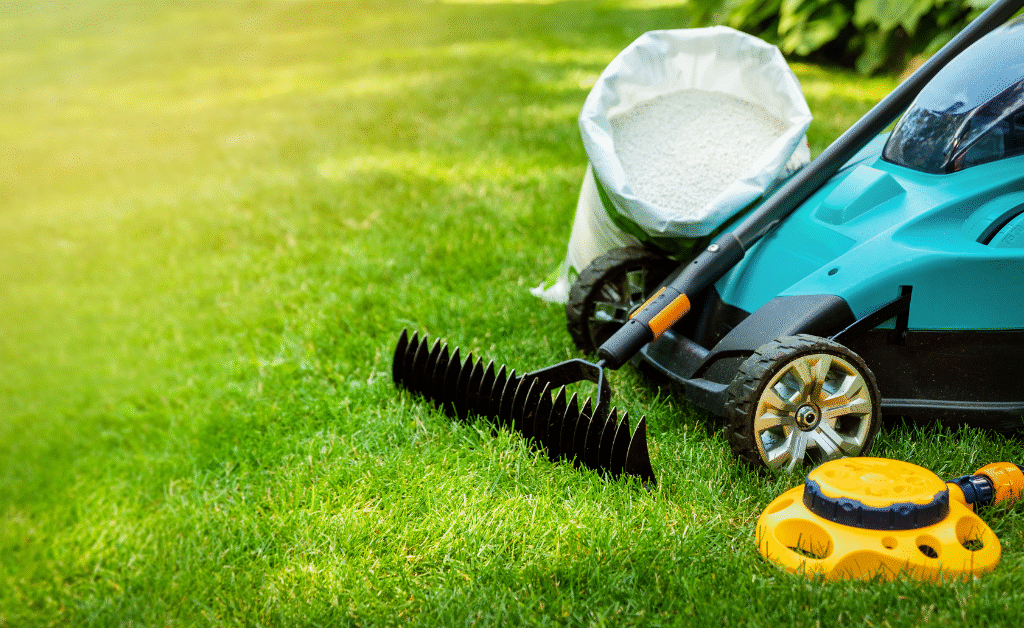As the air turns crisp, leaves begin to fall, and the days grow shorter, many homeowners struggle to maintain the lush, green appearance of their lawns. By October, grass is transitioning into dormancy or slowing down growth, depending on your region and grass type. But with the right care, your lawn can remain vibrant, resilient, and picture-perfect throughout the fall season.
In this guide, we’ll explore practical, science-backed strategies on how to keep your lawn green through October. From proper mowing techniques to fall fertilization and irrigation practices, these tips will help you extend the beauty of your turf well into the cooler months.
1. Understand Your Grass Type

The first step in keeping your lawn green is understanding whether you have cool-season grass or warm-season grass, since each responds differently in fall.
- Cool-season grasses (Kentucky bluegrass, perennial ryegrass, tall fescue): Thrive in cooler temperatures and typically peak in growth during spring and fall. With proper care, they stay green through October and sometimes even beyond in mild climates.
- Warm-season grasses (Bermuda, zoysia, centipede, St. Augustine): Begin to slow down and turn brown as soil temperatures drop. To keep them green longer, overseeding with cool-season grass may be necessary.
Knowing your grass type helps you tailor care practices for maximum color and vigor.
2. Adjust Mowing Practices for Fall

Mowing remains critical in October, though growth slows compared to summer. Follow these tips:
- Lower the mowing height slightly – Gradually reduce your mowing height by about ½ inch in early fall. This helps sunlight reach the grass crown, strengthens roots, and prevents snow mold in colder regions. Avoid scalping, which weakens grass.
- Follow the one-third rule – Never cut more than one-third of the blade length at once, as this stresses turf.
- Keep blades sharp – Dull mower blades tear grass, causing brown tips and increasing disease susceptibility.
Regular mowing encourages denser growth, which translates into greener color and better health through October.
3. Fertilize at the Right Time
Fall fertilization is often considered the most important feeding of the year. Fertilizer replenishes nutrients used during summer stress and promotes strong root development.
- Cool-season grasses – Apply a balanced or nitrogen-rich fertilizer in early to mid-October. This supports active growth, enhances color, and prepares turf for winter.
- Warm-season grasses – Fertilize in early fall, before growth slows significantly. Opt for a fertilizer with less nitrogen and more potassium to improve cold tolerance.
Pro tip: Use a slow-release nitrogen fertilizer for prolonged feeding without the risk of burning or excessive top growth.
4. Water Deeply and Strategically

Cooler weather often reduces evaporation, but don’t neglect watering in October. Grass still needs about 1 to 1.5 inches of water per week, especially cool-season varieties that remain actively growing.
- Water in the morning to reduce disease risk.
- Deep, infrequent watering encourages strong root growth, essential for maintaining green color.
- Use rain as an ally – In wetter climates, adjust irrigation schedules accordingly.
By ensuring consistent soil moisture, your lawn will remain greener longer and avoid the dull, patchy look that comes with drought stress.
5. Overseed Bare Spots
By October, summer damage may still be visible in the form of thin or bare patches. Fall overseeding fills these gaps and maintains uniform green color.
- Choose a high-quality cool-season grass seed for overseeding. Ryegrass, for example, germinates quickly and adds instant green.
- Prepare the area by raking to expose soil.
- Spread seed evenly, lightly cover with compost or soil, and water consistently until germination.
For warm-season lawns, overseeding with ryegrass ensures green coverage throughout October and into winter when the primary grass begins to fade.
6. Aerate for Better Growth
Compacted soil prevents water, nutrients, and oxygen from reaching the root zone. October is an ideal time to core aerate cool-season lawns.
Benefits of aeration include:
- Deeper root systems.
- Better fertilizer and water penetration.
- Reduced thatch buildup.
- A more vibrant green appearance.
For homeowners in warmer regions, aeration may be done earlier in late summer, but cool-season lawns respond exceptionally well when aerated in October.
7. Control Weeds Before Winter

Weeds not only compete for nutrients but also make lawns appear patchy and uneven. Fall is one of the best times to apply herbicides because weeds are actively storing energy in their roots.
- Use a selective broadleaf herbicide for weeds like dandelions, clover, or chickweed.
- Apply herbicide on a day when temperatures are mild and rain isn’t expected for 24 hours.
- For natural alternatives, hand-pulling weeds after rain is highly effective.
Controlling weeds in October ensures your lawn remains uniform and green without intruding patches.
8. Rake Leaves and Remove Debris
While colorful autumn leaves create a picturesque landscape, leaving them on your lawn for too long is a recipe for disaster.
- Thick leaf layers block sunlight, restrict airflow, and trap moisture, leading to fungal growth.
- Leaves left on the lawn smother grass, causing thinning and browning.
Regular raking or using a mulching mower keeps grass exposed and allows it to photosynthesize. Mulched leaves can also add organic matter to the soil, improving long-term health.
9. Manage Thatch Buildup
A thatch layer thicker than ½ inch prevents water and nutrients from reaching the roots. If your lawn feels spongy, dethatching may be necessary.
- For small lawns, use a manual dethatching rake.
- For larger lawns or heavier buildup, consider power raking or verticutting.
Performing dethatching in early October for cool-season grasses ensures recovery before winter, keeping lawns greener and healthier.
10. Feed the Soil with Compost

Adding a thin layer (¼ inch) of compost in October improves soil structure, boosts microbial activity, and enhances water retention. This topdressing provides a steady source of nutrients that helps keep grass greener naturally without over-reliance on synthetic fertilizers.
11. Protect Against Frost Damage
In colder regions, frost can arrive by late October. While frost alone doesn’t kill grass, walking on frosted lawns can crush blades, leaving them brown and brittle.
- Avoid foot traffic on frosted grass.
- Ensure grass isn’t excessively long going into frost periods, as tall blades bend and break more easily.
With careful handling, grass can maintain its green vibrancy despite occasional frosts.
12. The Role of Regional Climate
Keeping grass green through October also depends on your geographic region:
- Northern states – Focus on fertilizing, overseeding, and aerating cool-season grasses for vibrant fall growth.
- Southern states – Transition warm-season lawns by overseeding with ryegrass and applying potassium-rich fertilizer for winter prep.
- Transitional zones – Combine both strategies depending on dominant grass type and local climate patterns.
Common Mistakes to Avoid
Many lawns fade too soon in October due to simple oversights. Here’s what to avoid:
- Neglecting fertilization – skipping fall feeding weakens root development.
- Overwatering – leads to shallow roots and fungal disease.
- Cutting grass too short – stresses turf and exposes it to cold damage.
- Leaving leaves piled up – smothers grass and kills patches.
Avoiding these mistakes ensures your lawn holds its lush green color as long as possible.
Final Thoughts
A green, healthy lawn in October doesn’t happen by accident—it requires a mix of timing, knowledge, and consistency. By adjusting mowing practices, fertilizing wisely, watering correctly, and addressing weeds, thatch, and bare spots, you can keep your lawn vibrant throughout fall.
Whether you’re in a cool-season region where grass thrives in October, or managing a warm-season lawn that needs overseeding to maintain color, these steps ensure your yard remains a source of pride before winter dormancy sets in.
With a little extra effort now, you’ll not only enjoy a lush lawn through October but also set the stage for a quicker, greener recovery in spring.
